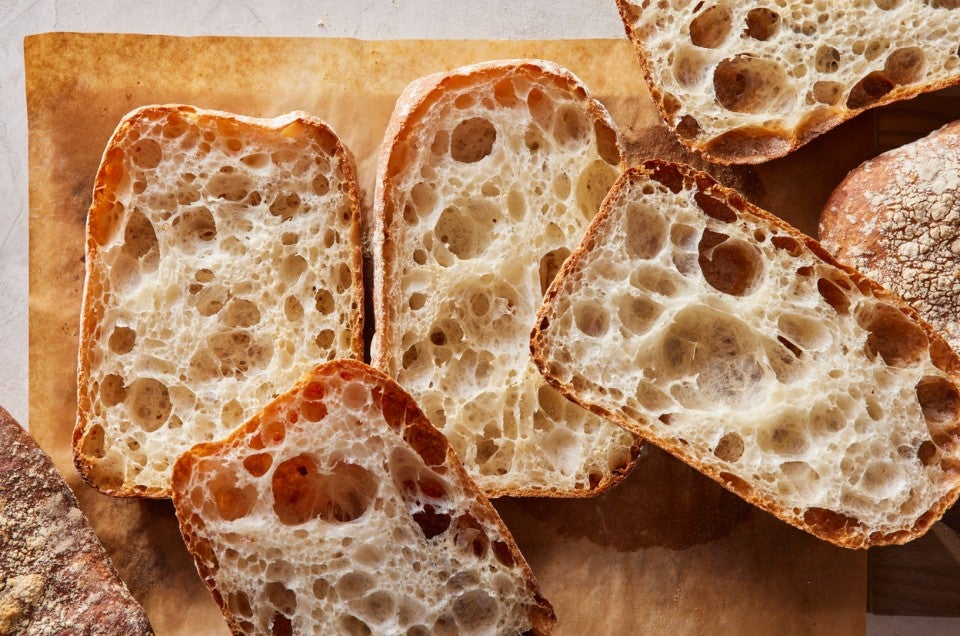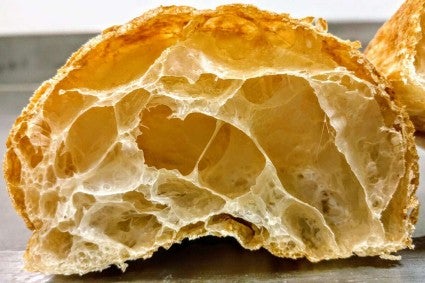Glass bread tastes as good as it looks (and it looks really, really good)
A beautiful bread made possible by bread flour.


 Recently I saw a loaf that stopped me in my tracks. It was a loaf that looked like it had all the qualities of a great bread: flavor, texture, sustenance. And most of all, beauty. Beauty, after all, is half the reason I bake. (Haven't you ever made something just because it’s gorgeous?)
Recently I saw a loaf that stopped me in my tracks. It was a loaf that looked like it had all the qualities of a great bread: flavor, texture, sustenance. And most of all, beauty. Beauty, after all, is half the reason I bake. (Haven't you ever made something just because it’s gorgeous?)
That loaf turned out to be Pan de Cristal, a traditional loaf from the Catalan region of Spain sometimes referred to as "glass bread." The outside of this loaf is unassuming — dark and crusty — and not exactly a showstopper. But wait. Hidden inside, lurking like crystals underneath a crust so crisp it seems fried, is a miraculously beautiful crumb. Threads of gluten stretch into glassy, translucent webs. Is it bread, I thought, or is it treasure?

It's both. And that’s what drew me in. I started asking questions: What magic makes Pan de Cristal possible? Will the recipe require days of attention, special flours, or mystical hands to transform four simple ingredients?
Luckily, I found the answers.
When I explore something new, I always start with architecture. In baking terms, what I mean is that I look inside the loaf at the structural components and ingredient ratios. I also consider method — the mixing, fermentation, and baking — and come up with a list of questions. You’ve seen me do this before from chocolate bread hacks to twists on traditional favorites.
The hydration will need to be dangerously high, around 100% in baker’s percentages (meaning, equal weights of flour and water). Compare this with baguettes (in the range of 65% to 75%) or ciabatta (around 80%), and you may be concerned. I don’t blame you. As designed, the dough will feel more like a batter than bread.
For leavening, I choose commercial yeast. The acidity of a sourdough culture isn't the flavor profile that I want. Let’s keep it simple: malty wheat, a well-baked crust, a drizzle of olive oil. Plus, I have time goals: I’d love to make this bread in a single afternoon. No preferment and a little commercial yeast will speed up the process.
Then there's fermentation. The dough will need time and folds to develop the necessary strength for its final proof. I'm not sure how much of each, but I do know that we’re chasing miracles here. This brings me to the crux of the challenge: How will it be possible to push this wet dough to the edge of its rise without collapsing?
Here’s how: Bread flour.

Sometimes baking requires a superhero. Bread flour, with enough strength to hold tons of water and support a long final proof without collapsing, is the caped hero we need. All-purpose could work but I would need to lower the hydration, sacrificing a key requirement for Pan de Cristal’s signature open structure.
Bread flour is also integral to creating a dough that's smooth, silky, and workable, despite the high hydration.
Early attempts involved yeasted preferments and lots of mechanical mixing. While the bread I made was flavorful, the crumb wasn’t much better than my ciabatta. Back to the drawing board.
First up, I needed to fix the most defining characteristic for this loaf: the holes. Since a long process with extensive mixing didn’t produce what I wanted, I went in the opposite direction: less mixing and a shorter process. My thought was that too much strength as a result of either development (mixing, folding, or time being the contributing factors) or fermentation, made my crumb structure too homogenous, not wildly open.
After several bakes with adjustments to mixing, number of folds, length of fermentation, and final rise, I found myself getting closer. The holes started to open, creating a collage of glassy, translucent bubbles, all connected within a network of random threads. The crust became thinner and crispier as I pushed the final rise further and further. As my cutting board was taken over by the piles of loaves, I began cutting them open as a parlor trick, shocking my family with the incredible results.
But rather than taking a bow after, “Wow, daddy, that’s amazing,” let’s give credit where it’s due. Please stand, a round of applause for bread flour — strong, elastic, ready for all the water and fermentation we can throw at it — the true star of this show.
So, if you'd like to see this transformation in action, give the recipe a whirl. Mix the dough just before noon, fold a few times between errands, Zoom meetings, dinner preparation, and life, and you'll have a hero at the table by dinnertime. Cue the applause!

In testing, enjoying, and sharing many loaves of Pan de Cristal, here are some things that I found helpful.
Just keep folding. On the flip side, if your dough doesn't match my above video exactly, or if you feel like it's more suited for pancakes than Pan, keep going. Unless there's a mistake with your measurements of flour or water, and as long as you're using great flour, the dough will definitely come around.
If you make this Pan de Cristal, please let us know — tag your photos #bakeoftheweek and maybe give @kingarthurbaking a shout-out, too. Happy baking!


April 30, 2022 at 3:56pm
I would like to see what the desired shape of the finished loaves are. The pictures in the recipe don't show this and it would be very handy to get a final look at the desired shape.
April 30, 2022 at 4:18pm
In reply to I would like to see what the… by Bruce G Merighi (not verified)
Hi Bruce, I will pass along your request to our recipe/content team!
April 22, 2022 at 8:32pm
So good, i couldn't wait for it to cool! After 15 min baking, i only baked like 5 min on upper third since i didnt want it to burn. Also temp was already 200f. When i ate it the inside was a tiny bit gummy so i inc the time for the 2nd batch
April 22, 2022 at 4:38pm
My dough never seems to strengthen. I have fresh yeast and KA bread dough. I weigh all ingredients and follow the recipe exactly. I let the dough rest for 20 minutes after mixing but my bowl fold looks nothing like the video. My dough is still soupy and falls through my fingers as I make the fold. The dough temperature is 78.5F. I keep the 20 minutes intervals performing the coil folds but the dough never really strengthens. I let is rest 80 minutes in an 8"x8" 2 quart pan. After 80 minutes it looks beautiful. It has risen to the top of the pan and you can see nice structure through the glass. When I turn it out, the dough deflates and won't hold its shape. It spreads out to be about 8" and never recovers. After 2 hours it hasn't really risen. But after baking there is some nice holes but the loaf is too big and therefore relatively flat. It does taste good though. How can I strengthen the dough so that it holds its shape?
April 25, 2022 at 2:19pm
In reply to My dough never seems to… by Charles Wolley (not verified)
Hi Charles, first make sure to oil the pan thoroughly with the 15g of olive oil. Rub the oil not only on the bottom of the pan, but on the sides as well. This will help the dough come together more successfully and should make your folding more productive. Since your dough was fairly warm and rose so well during the 80 minute rise, you might want to consider gently transferring the dough a bit earlier (when it hasn't risen quite so high in the pan). This may help avoid some of the deflating you experienced at that point, and will make dividing the dough easier to accomplish as well. Keep in mind that this dough isn't going to develop the kind of sturdy structure that a lower hydration dough will, so a gentle touch is key.
March 18, 2022 at 2:00pm
Can you use the tangshong method with this bread to make it last longer? Thanks.
March 18, 2022 at 2:48pm
In reply to Can you use the tangshong… by NEA (not verified)
Hi NEA,
No, tangzhong isn't the best fit for this bread, best to stick with it as written for best results this unique bread.
February 17, 2022 at 4:37pm
I, too, put the olive oil in the dough mixture and then also oiled the pan. The dough has no strength. I did take the dough out of the pan into the counter and did about 5 minutes of slap and fold which didn't result in getting strength. I'm not sure how to rescue this recipe. I'm thinking I should just start over.
February 23, 2022 at 10:48am
In reply to I, too, put the olive oil in… by Claudia Little (not verified)
Sorry for the soupy dough Claudia! This dough really is a miracle when it comes together and just takes a combination of time, folds and bread flour to be able to build strength. Feel free to call our baker's hotline at (855) 371-2253 for more in-depth instruction on how to make this recipe work for you. Looking forward to your call!
March 24, 2022 at 4:24pm
In reply to I, too, put the olive oil in… by Claudia Little (not verified)
Me too…….
Pagination